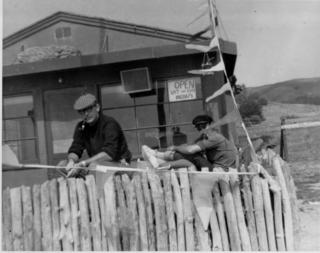What most astonished Pete Douglas was the appearance of artist Michael McCracken with his entourage in tow. McCracken, who resembled 1950s actor Douglas Fairbanks, Jr., ws well known on the beat scene in San Francisco. Pete says that for awhile McCracken was “the beat leader in Princeton…along with these legendary characters right out of the book ‘On The Road.’ When these characters traveled down Highway 1, “they fell in at Princeton. He (McCracken) was what you’d call hard core on the scene…”
McCracken’s “scene” was at Princeton’s Abalone Factory, an old wood frame plant that once had processed fresh abalone. McCracken painted abstract floor-to-ceiling murals and lived there with his fellow free spirit friends. Also sharing the cramped space were goats that clomped across the floor and exotic birds that swooped and flew through the air.
Pete Douglas says that he was carefully watched by the paranoid McCracken who “suspected me because I was employed. That was enough right there. As a probation officer, that was even worse.”
On that hot Sunday afternoon–while Michael McCracken and friends romped and rolled in the weeds that grew in front of the Ebb Tide Cafe and the Brazilian soundtrack from Black Orpheus blasted in the background–someone arrived with the svelte Miss San Mateo, a beauty whom Pete says became Karen Black, the well known movie star. He remembered her wearing the kind of bathing attire suitable for a beauty competition, “out of character with the raunchy scene, posing on the picnic table.”
Into the mix, the sociology teacher arrived, his troop of open-eyed students trailing behind him.
“They arrive,” mused Pete, “with these cases of beer. Finally we coaxed them in, and they were foolish enough to start bringing in their beer–which never even reached the front door.”
By then the scene had become what Douglas defines as “a hard party. Carrying on. Arguing. It was going on indoors and outdoors everywhere. There were even people on the roof.” Pete had never seen such a “totally involved party” in his life, “in which there weren’t passive spectators. They were oblivious to anything going on.”
They were oblivious even to the cars accumulating on unpaved, rocky Mirada Road–cars that moved slower and slower, finally grinding to a halt.
Gridlock.
“One of my tricks was to go out and direct traffic,” laughed Douglas. But his gallant efforts were hopeless. “By now I’m dancing and I look out and I see we were ringed. There was a crowd just standing there and watching us.” He says some of those watching were people who had abandoned their vehicles. What else was there to do but join the party?
And how did the party end?
Pete Douglas told me that he doesn’t remember.
But it was the end of a decade–and, in a way, the end of innocence. The horror of the Vietnam War loomed in the future–and the “beats” of the 1950s would usher in their socially committed brothers and sisters of the 60s.
End







